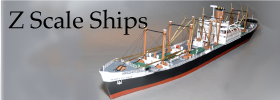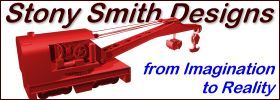Scratch building is defined in Wikipedia as “The process of building a scale model "from scratch", ie. from raw materials, rather than building it from a commercial kit, kit bashing or buying it pre-assembled.”
Wikipedia further explains the motives as “The reasons hobbyists scratchbuild may vary. Often a desired model is unavailable in kit form in the desired scale, or entirely non-existent. Sometimes the hobbyist may be dissatisfied with the accuracy or detail of kits that are available. Other times a hobbyist will opt to scratchbuild simply for the challenge. Less frequently a hobbyist will scratchbuild out of economy, as sometimes the raw materials cost less than a packaged commercial kit.”
From here I would like to introduce Evergreen Scale Models. I am sure many Z scale modelers have a small arsenal of their products stashed away for current or future projects.
I emailed Evergreen Scale Models recently with some questions, and I would like to share their response with you.
Hello John, Thanks for your interest, and for using Evergreen styrene products. Happy to answer your questions:
What are your recommendations for proper storage of your products? Store styrene away from heat sources to prevent warping, and keep it out of sunlight. UV light slowly breaks down unpainted styrene. However, paint on the model will provide the necessary protection to prevent breakdown. Weak UV from indoor sources are not a significant problem.
What type of glue(s) or bonding material would you recommend for your sheet and shape products? Styrene is best bonded with a liquid styrene solvent, which chemically welds the styrene parts. Common brands are: Testors Liquid Cement, Tenax 7R, and Ambroid Pro-Weld. Methyl-Ethyl-Ketone (MEK), found at most hardware stores, is also suitable. Whichever solvent you use, the styrene surface must be unpainted, as solvents won't bond painted styrene. CA (Superglue) and epoxy can also be used, but they are not as strong as a solvent bond.
"The most common mistake I see is a new scratchbuilder taking on too big a project for his or her first attempt. To avoid this mistake, I'd recommend someone new to scratchbuilding start with a simple project, like a small yard office. A new scratchbuilder will make mistakes, but they'll learn by their mistakes. Once they are pleased with their results, then they can consider moving on to bigger and/or more complicated scratchbuilding projects. One of the best things a new person can do is use all resources available to learn about scratchbuilding. There are many books in the hobby press, including Evergreen's how-to book, "Styrene Modeling". Don't limit the search to just model railroad titles, look at what other hobbyist are doing. The plastic kit modelers have developed innovative ways to build models with styrene and exciting ways to finish their models. Bottom line; mistakes will happen. Use them as a learning tool and keep trying. Eventually the results of learning will be their own reward!A second common mistake is using the wrong adhesive to bond materials. Some glues will warp or distort the plastic's surface, particularly if excess glue is applied to the parts (a common mistake for beginners). Clear styrene is very susceptible to marring from using too much or the wrong adhesive. Canopy cement or Future acrylic floor finish works well for affixing clear styrene to other parts (even a small amount of white glue will work if there is no stress on the parts being joined). At some point, a new start to the project may the only cure for too many mistakes. But the new scratchbuilder will learn and eventually become proficient in their efforts."


















Comments powered by CComment